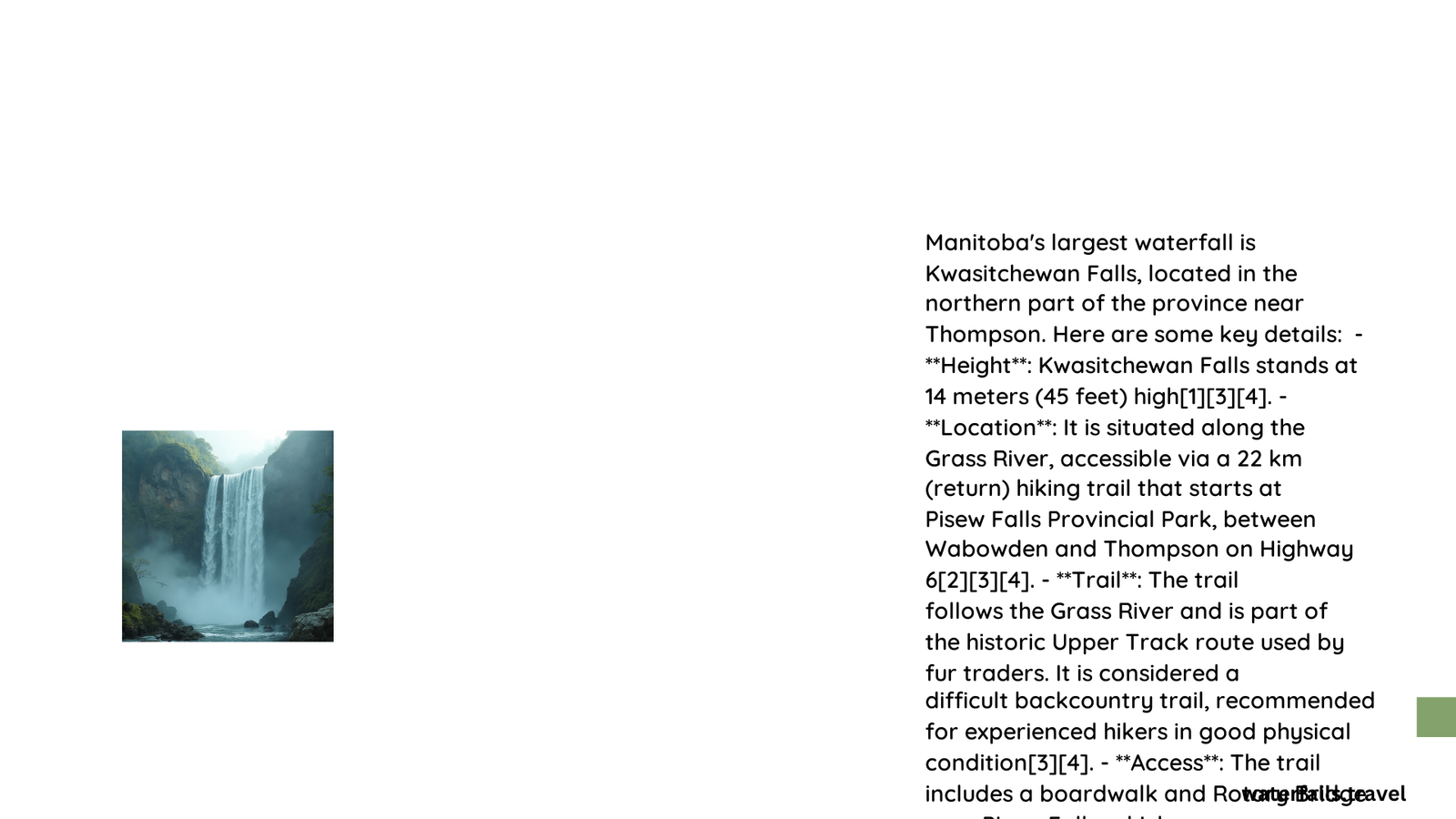Kwasitchewan Falls, located in Pisew Falls Provincial Park in northern Manitoba, is the province’s highest waterfall. Standing at 14 meters (46 feet) tall, this natural wonder is a testament to Manitoba’s rugged beauty. Accessible via a challenging 31-kilometer round-trip hike, Kwasitchewan Falls offers adventurers a rewarding experience amidst the wilderness. The waterfall’s remote location and the journey required to reach it make it a prized destination for outdoor enthusiasts and nature photographers alike.
Where is Manitoba’s Largest Waterfall Located?
Kwasitchewan Falls is situated in the heart of Manitoba’s northern wilderness, within Pisew Falls Provincial Park. The journey to this majestic waterfall begins at the Pisew Falls parking lot, approximately 76 kilometers south of Thompson. While the exact GPS coordinates of Kwasitchewan Falls are not widely publicized, the trailhead’s location is well-known and serves as the starting point for this adventurous hike.
The trail to Kwasitchewan Falls winds through dense boreal forest, following the course of the Grass River and skirting Phillips Lake. This remote setting contributes to the waterfall’s pristine condition and the sense of discovery that hikers experience upon reaching it.
How Tall is Manitoba’s Largest Waterfall?

Kwasitchewan Falls boasts an impressive height of 14 meters (46 feet), making it the tallest waterfall in Manitoba. To put this into perspective, let’s compare it with other notable waterfalls in the province:
| Waterfall | Height |
|---|---|
| Kwasitchewan Falls | 14 meters (46 feet) |
| Pisew Falls | 13 meters (43 feet) |
| Wekusko Falls | 12 meters (39 feet) |
This comparison highlights Kwasitchewan Falls’ status as Manitoba’s largest waterfall, surpassing other well-known cascades in the region.
When is the Best Time to Visit Manitoba’s Largest Waterfall?
The optimal time to visit Kwasitchewan Falls depends on several factors, including water flow, accessibility, and personal preferences. Here are some considerations:
- Spring and Early Summer:
- Peak water flow due to spring melt
- Dramatic views with potential ice chunks
-
Lush, green surroundings
-
Late Summer and Fall:
- More stable weather conditions
- Potentially easier hiking conditions
-
Autumn colors in the surrounding forest
-
Winter:
- Frozen waterfall spectacle
- Challenging and potentially dangerous hiking conditions
- Requires advanced winter hiking skills and equipment
For photography enthusiasts, early morning and late afternoon offer the best lighting conditions, regardless of the season. The softer light during these ‘golden hours’ can enhance the waterfall’s beauty and create stunning visual effects.
What Amenities are Available at Manitoba’s Largest Waterfall?
Given the remote nature of Kwasitchewan Falls, amenities are limited. Here’s what visitors can expect:
- Parking: Available at the Pisew Falls parking lot (trailhead)
- Trail: Unmarked, challenging 31-kilometer round-trip hike
- Facilities: None along the trail or at the falls
- Guided Tours: Not officially available, but local guides may offer services
It’s crucial for hikers to come prepared with:
- GPS navigation tools
- Ample food and water
- Appropriate hiking gear and clothing
- First aid kit
- Emergency communication device
How Challenging is the Hike to Manitoba’s Largest Waterfall?
The trek to Kwasitchewan Falls is not for the faint of heart. Here’s what hikers can expect:
- Distance: 31-kilometer round trip
- Terrain:
- Boggy sections
- Tree roots and fallen branches
- Steep climbs
- Navigation:
- No official trail markers
- GPS navigation recommended
- Duration: Typically requires 1-2 days, with overnight camping
Given these challenges, the hike is best suited for experienced hikers with proper preparation and equipment.
What Makes Manitoba’s Largest Waterfall Unique?
Kwasitchewan Falls stands out not only for its height but also for several other factors:
- Remote Location: Its isolation contributes to its pristine condition and the sense of adventure in reaching it.
- Geological Significance: The falls showcase the rugged Canadian Shield landscape.
- Ecological Importance: The surrounding area is home to diverse flora and fauna.
- Cultural Heritage: The region has historical significance for Indigenous peoples.
- Photographic Opportunities: The falls offer stunning visuals in various seasons and light conditions.
How Can Visitors Prepare for a Trip to Manitoba’s Largest Waterfall?
Proper preparation is key to a safe and enjoyable visit to Kwasitchewan Falls. Here’s a checklist for potential visitors:
- Research the trail conditions and weather forecast
- Inform someone of your hiking plans
- Pack appropriate gear:
- Sturdy hiking boots
- Weather-appropriate clothing (layers recommended)
- Camping equipment for overnight stays
- Sufficient food and water
- Navigation tools (GPS, map, compass)
- First aid kit and emergency supplies
- Consider hiring a local guide for added safety and insight
- Respect the environment and practice Leave No Trace principles
By thoroughly preparing and respecting the challenges of the hike, visitors can fully appreciate the majesty of Manitoba’s largest waterfall and the surrounding wilderness.
References:
1. Wikipedia – Kwasitchewan Falls
2. TripAdvisor – Kwasitchewan Falls
3. Canadian Geographic – 5 must-see spots in Manitoba’s Waterfall Alley
